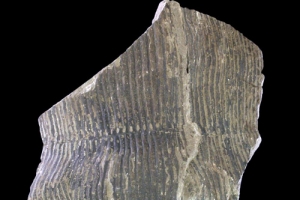Fossils come in all shapes and sizes and some of them are only visible with the naked eye or magnifying glass. We focus on those fossils that you are most likely to encounter and might possibly collect from rocks using normal tools. The most common ways in which plant fossils are preserved are:
Compressions
Plant parts are flattened and at least some of the original plant material remains. Leaves are often preserved as compressions.
Impressions (or molds)
Plant parts are flattened, but all of the original plant material has decayed away. Only the shape or texture of the plant remains, pressed into the mud or sand. Bark is often preserved as an impression.
Casts
Some plant parts are hollow or have cells that decay quickly. If mud or sand enters the empty places, it can solidify into rock in the shape of the original plant part. Stems and roots are often preserved as casts.
Permineralizations
Permineralizations are plant debris preserved when water with dissolved minerals seeps into the cells and spaces of decaying plant tissues. The minerals crystallized, preserving the form of the plant. An example is petrified wood: water carrying the mineral silica seeps into wood and impurities in the mineral cause the strong colors we see in many pieces of petrified wood. Another example is coal balls. Water carrying calcite seeps into all of the cells and spaces in the peat. Coal balls can be sectioned into peels that provide extremely detailed fossils in 3-D.
Many fossils, One tree
To reconstruct an ancient plant, paleobotanists must find and study individual plant parts. Each part may be preserved in a different way. When found separately, each piece of the plant is given a separate scientific name and when all the pieces are found, the entire plant takes its name from the piece that was named first.








